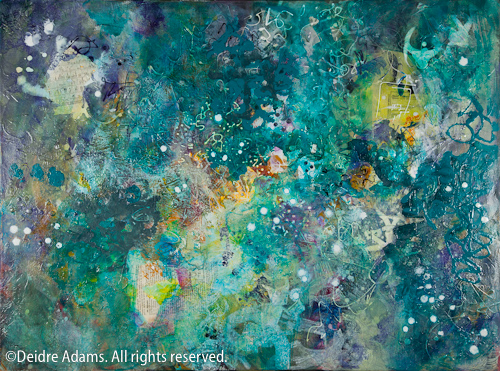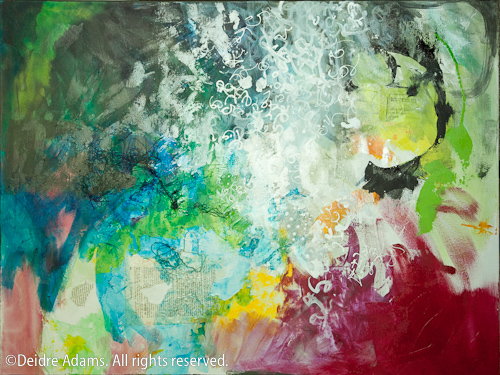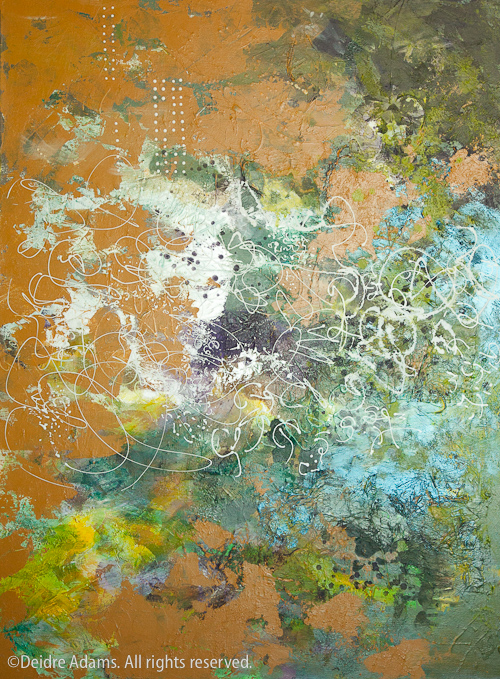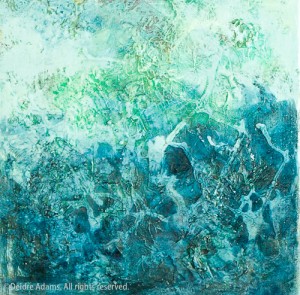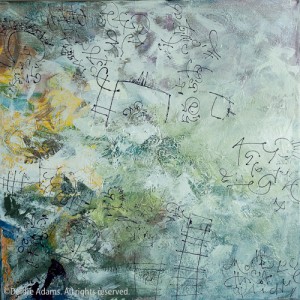339. Resonance
339. Resonance, 30 x 40 inches, acrylic & mixed media on panel-mounted canvas, ©2010 Deidre Adams
This is a new painting I finished last week. I’m quite happy with it. One question I’m asked frequently is how do I know when it’s done? I’ll admit that I struggle with that. The best answer I have is that it’s finished when it no longer nags at me. Each painting is done in stages. I work on it for awhile, then I set it aside. I keep several paintings, in various stages of completion, standing up where I can see them all around the studio, which spills over into my bedroom and even the bathroom. Sometimes I don’t come back to them for quite awhile, but they stay there in front of me where I see them every time I walk by. They are almost part of the landscape, but somewhere in my subconscious mind I’m thinking about each one, and when inspiration hits for a particular one, it gets another working turn. I can’t take it out of the lineup until I have declared it officially done.
At one point in the process for this particular painting, I thought it might be finished when it looked like this:
339. Resonance in progress
But I just wasn’t sure. It seemed OK, probably, but was it really? Somehow it seemed it wasn’t quite rich enough to me at this stage. This is when it’s the scariest for me. What if I do more to something that’s really pretty OK, and I ruin it? Actually, I’ve done that many times now, and so I’ve figured out that if that happens, I just keep going and eventually I can resolve it. Each of my finished paintings has had several different identities throughout its life. I could have called it done at any point, but I would not have been completely satisfied.
Here’s an even earlier stage of this painting:
339. Resonance in progress, early stages
The title comes from the 1939 edition of Physics by Erich Hausmann and Edgar P. Slack, a couple of pages of which are collaged into this painting.
339. Resonance, detail
This painting started out on stretched canvas. Normally, I like to work on panels because I build up textures by putting many layers of paint and medium on the surface. I don’t have any concerns about structural integrity when it’s on a hard surface. But when I started this painting, I didn’t have any panels handy, and I did have some canvases in storage (more about that here). I didn’t think I’d be making any great masterpieces; I had just come off a longish dry spell and all I cared about was getting back into the studio to paint!
When I got into the process of this painting, however, I became very committed to it and I put a lot of time and energy into it. And I do really love it. However, the weight of all the layered paint on the canvas was too much for the support, and it was obvious that it wouldn’t stand up to being moved around a lot. But I came up with a great solution. I have since bought some very nice panels, and for this painting, it was an easy matter of mounting it onto a panel with Golden gel medium.
I first thought I might need to use some kind of glue, but in researching it (don’t you LOVE the Google!), I found blog posts by people who had used soft gel medium to mount canvas to panel prior to painting. But there was nothing about using it for a finished painting, and I wasn’t sure the medium would be strong enough. So I called Golden tech support. I spoke to a very knowledgeable individual and explained the problem. He said that the Golden medium is preferable to glue because it is more stable chemically and not prone to breaking down over time like glue. He said that I should use the regular weight gel instead of soft gel, though, because it would better support the heavier weight. This was welcome news to me, since I already had a gallon tub of it sitting on my work table.
So all I had to do was pry out the staples holding the canvas on the stretchers and trim off the sides (but leaving about a half-inch safety border). I laid it down on top of the panel and got it positioned the way I wanted it, and then weighted it in the center with heavy books so it wouldn’t move. Then, starting at one end, I lifted up that side of the canvas, and with a wide putty knife, I spread on a layer of gel about a third of the length of the panel. I rolled the canvas back down from the middle, smoothing and applying pressure by hand as I went. I used a rolling pin over a towel like a large brayer to press it into place. Then I repeated the procedure from the other side in two stages: center, then the final end. I gave extra attention to the edges to make sure they were securely pressed down.
The gel is tacky enough that I could keep working on it without disturbing the positioning, so I decided that it would be best to get the edges trimmed before the gel dried and became difficult to remove. A lot of it splooges out the sides. So at that point, I turned the whole thing over and cleaned up as much of the excess gel as possible, then I used an X-acto knife to trim the canvas flush to the edge of the panel. After it dried, I sanded and painted the edges of the canvas to match top layer of the panel. Voilà!


